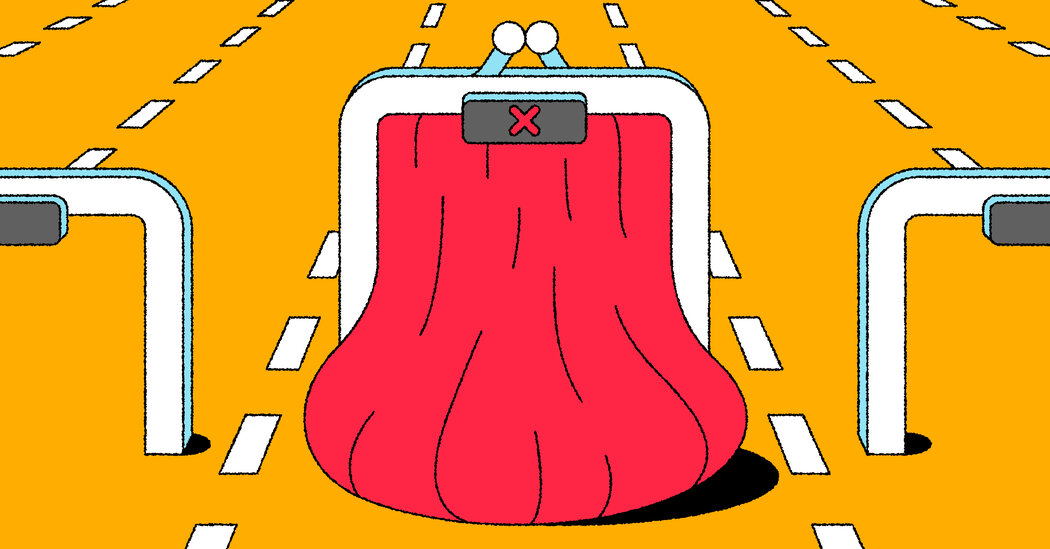Remember when you used to have to keep a pile of quarters nearby to pay highway tolls? Cashless tolls have eliminated most of the long, time-eating lines at highway tollbooths, but they have a downside: They can lead to hefty bills for drivers on unfamiliar roads.
All-electronic tolling has become more popular since a highway in Denver adopted the practice in 2009, said Mark Muriello, director of policy and government affairs at the International Bridge, Tunnel and Turnpike Association. The group, he said, represents 130 toll operators in 34 states.
Now, tollbooths on about two-thirds of the 6,600 miles of roads overseen by the group’s members no longer accept cash, he said. Instead, drivers are charged automatically when they pass an automated toll station or tower, using devices or stickers called transponders attached to their windshield. Toll roads also use “pay by plate” systems, which snap a photo of your license plate if you don’t have a device.
Proponents say cashless tolling is convenient because it reduces traffic jams and offers environmental benefits, like reduced emissions from idling engines. “Customers like it because they don’t have to stop,” Mr. Muriello said.
Operators typically offer a discount on tolls paid using transponders to encourage drivers to participate. The fees are paid out of a prepaid tolling account.
Unfortunately, there isn’t yet an electronic toll pass that works nationally because systems use different protocols that don’t communicate well with one another, Mr. Muriello said. That means out-of-state drivers can face unexpected bills, whether driving their personal car or a rental.
I learned this recently on a road trip to the Chicago area with my husband. We drove our own car to attend college soccer games and noticed several toll signs on our route. But, in a hurry to get to the events, we didn’t sort out how to pay.
After we arrived home, a bill for 10 tolls totaling $21.70 arrived in the mail from the Illinois Tollway. Because we didn’t have a toll account — called I-Pass in Illinois — the system photographed our license plate to generate an invoice. I tossed it in a stack of paperwork — and then promptly forgot about it.
Another invoice arrived a few weeks later, with an extra $3 fee per toll added. My bill was now $51.70. I finally went to the tollway website and paid by credit card.
In such cases, disputing tolls is often a waste of time, said Charles Leocha, president of Travelers United, a nonprofit advocacy group. “They just keep adding on fees,” he said.
Mr. Leocha recommends doing some research ahead of time if you’re traveling by car. Most states offer online maps showing toll roads, so you can see if it’s possible to devise a route that avoids them. The states also provide calculators so you can tally the amount you’ll be charged if you do use toll roads. (You can also try Google Maps and apps like Waze.)
Some tolls accept both wireless payments and cash, and some still are cash only — although those are on the wane. Mr. Leocha still takes rolls of quarters with him when he travels by car, he said, in case he encounters an old-fashioned cash toll.
Should you get a pay-by-plate invoice, he said, don’t ignore it (as I mistakenly did). Pay promptly to avoid extra fees.
If you travel frequently by car to an area with lots of tolls or if you are planning an extended trip, you might consider signing up online for a prepaid account with the relevant toll system and having a transponder shipped to you (there’s often no fee). Install it in your car before you travel so tolls will be automatically deducted and you’ll qualify for any discounts. (My original bill would have been less than $11 if I had done that because Illinois offers a 50 percent discount if you have a transponder.)
Mr. Muriello said the toll industry was making progress on creating universal “interoperability” so passes could be used across the country.
“We are working very hard toward that goal,” said PJ Wilkins, executive director at E-ZPass Group, whose members use a cashless system that works in 19 states, mostly in the eastern half of the country (including popular vacation states like Florida and Maine). It also works on some roads in Michigan, he said, and he expects it to expand to more states by 2025. (Another multistate system is PikePass, which works in Kansas, Oklahoma, Texas and Florida, except for certain toll roads in the Orlando area, a spokeswoman said.)
If you have E-ZPass for your car, your account will be automatically charged for tolls in any of the compatible states. (You may not get as favorable a rate as you do in your home jurisdiction, however, because some states give extra discounts to residents and regular commuters. But you’ll typically pay less than you would if you lacked a pass and were charged under a pay-by-plate option.)
Another good option if you don’t already have E-ZPass, Mr. Wilkins said, is a Uni transponder, which is issued by the Central Florida Expressway Authority but works in all the E-ZPass-compatible states. You can buy a portable tag online for about $15, said Brian Hutchings, a spokesman for the authority.
Here are some questions and answers about cashless tolling:
Can I use my personal transponder in rental cars?
In many cases, yes. Using your own E-ZPass transponder when you rent a car can help save you money if you are renting in the states that use the system, Mr. Wilkins said. That helps avoid extra daily or weekly fees that car rental companies may tack on if you rent one of their transponders or enroll in an alternative toll-payment system. Policies vary by rental car company and location. Some charge a fee only if you pay a toll, but some may charge fees for renting the device whether or not you incur a toll.
If you don’t have your own device and decline to rent one from the rental car company — but rack up tolls anyway — companies may charge your credit card for the tolls, plus a hefty administrative fee. (This also happened to me recently, on a different road trip in a rental car; a $1.90 toll resulted in a $25 fee charged to my credit card.)
There are exceptions. Some toll systems offer transponders embedded in pliable plastic stickers. The stickers, however, typically can’t be removed and used in another car because the antenna breaks if you rip it off the windshield. If you want to use a transponder in multiple cars, you’ll typically need a removable, hard plastic transponder, known as a tag. (FasTrak, a wireless system used throughout California, offers both options.)
Travelers flying round-trip to Orlando International Airport can use a special app to reserve a free, temporary toll pass that works with most on-site car rental companies, and users get the lowest toll rates while visiting the state.
Do toll roads make more money with cashless tolling?
Mr. Muriello contends that it can be more costly for some operators if people don’t open prepaid accounts because of the equipment needed to photograph license plates, locate car owners and mail invoices to nonparticipating drivers. Some out-of-state drivers simply ignore the bills, and license-plate tampering to avoid toll cameras is becoming more common, according to a report in City Journal, a publication of the conservative Manhattan Institute for Policy Research.




